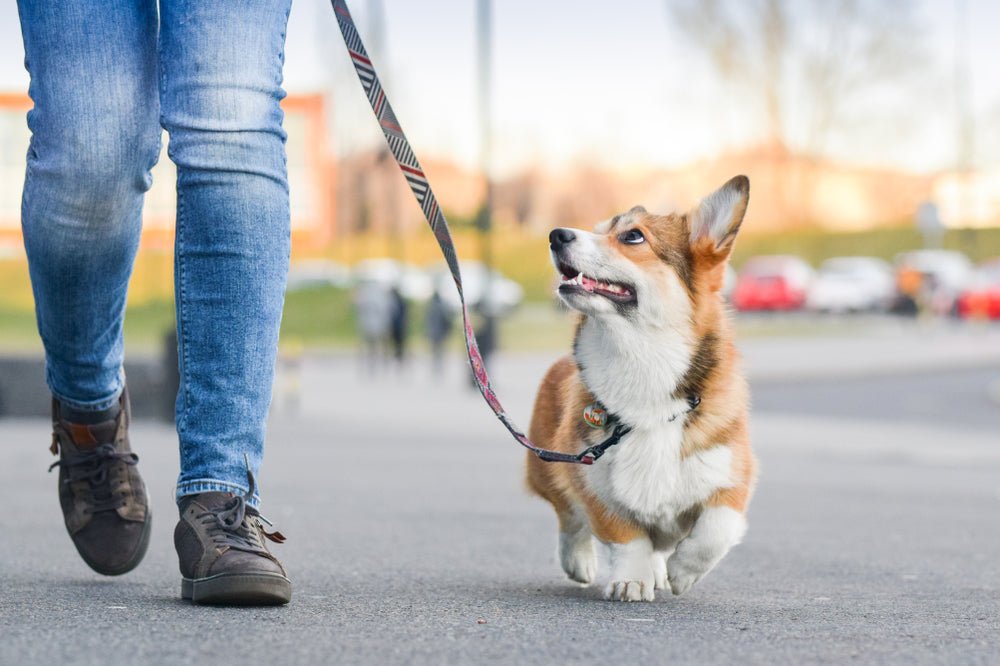Table of Contents
Training a dog to walk on a leash is an essential skill that ensures enjoyable and stress-free walks for both you and your pet. Understanding training a dog to walk on a leash can help you implement effective techniques and make your walks more pleasant. This guide provides essential tips to help you train your dog to walk calmly and confidently on a leash.

1. Choose the Right Equipment
Selecting the right leash and collar is the first step in successful leash training.
- Leash Type: Use a standard leash (4-6 feet) for better control.
- Collar or Harness: Choose a comfortable collar or harness suitable for your dog’s size and breed.
- Proper Fit: Ensure the collar or harness fits snugly but not too tight.
2. Start Indoors
Begin training your dog to walk on a leash indoors, where there are fewer distractions.
- Short Sessions: Keep initial training sessions short and positive.
- Controlled Environment: Use a quiet, controlled environment to minimize distractions.
- Positive Reinforcement: Reward your dog with treats and praise for good behavior.
3. Introduce the Leash Gradually
Allow your dog to get used to the leash before starting to walk with it.
- Let Them Sniff: Let your dog sniff and explore the leash before attaching it.
- Attach Indoors: Attach the leash while indoors and let your dog drag it around to get used to the sensation.
- Supervision: Supervise your dog to ensure they don’t get tangled or scared.
4. Use Treats and Praise
Positive reinforcement with treats and praise is key to successful leash training.
- Reward Good Behavior: Reward your dog with treats and praise when they walk calmly on the leash.
- Frequent Rewards: Use frequent rewards at the beginning, gradually decreasing as your dog improves.
- Consistency: Be consistent with rewards to reinforce good behavior.
5. Set a Walking Routine
Establishing a consistent walking routine helps your dog understand what to expect.
- Same Time: Walk your dog at the same times each day to establish a routine.
- Same Route: Start with the same route until your dog becomes comfortable, then gradually introduce new routes.
- Consistency: Consistency in your routine helps your dog feel secure and confident.
6. Teach Basic Commands
Teaching basic commands like “sit” and “stay” can help with leash training.
- Start with Sit: Teach your dog to sit before attaching the leash.
- Stay Command: Use the stay command to keep your dog calm and still when needed.
- Practice Commands: Regularly practice these commands to reinforce good behavior.
7. Address Pulling
Pulling on the leash is a common issue. Teach your dog to walk beside you instead.
- Stop and Stand Still: Stop walking and stand still when your dog starts pulling.
- Change Direction: Change direction or make a U-turn to redirect your dog’s attention.
- Reward for Loose Leash: Reward your dog when they walk with a loose leash beside you.
8. Be Patient and Consistent
Patience and consistency are crucial for successful leash training.
- Stay Calm: Remain calm and patient, especially if your dog is struggling.
- Consistency: Be consistent with commands, rewards, and walking routines.
- Encouragement: Encourage and praise your dog regularly to boost their confidence.
9. Gradually Increase Distractions
Once your dog is comfortable walking on a leash indoors, gradually introduce outdoor distractions.
- Quiet Streets: Start with quiet streets or parks with minimal distractions.
- Slow Introduction: Gradually increase the level of distractions as your dog becomes more confident.
- Reward Focus: Reward your dog for staying focused on you despite distractions.
10. Regular Practice
Regular practice is essential to reinforce good leash walking behavior.
- Daily Walks: Take your dog for daily walks to practice leash training.
- Short Sessions: Keep sessions short and positive to maintain your dog’s interest.
- Consistency: Regular practice helps your dog develop and maintain good walking habits.
Additional Resources on Training a Dog to Walk on a Leash
For more detailed information and support, check out these trusted resources:
- American Kennel Club: How to Train Your Dog to Walk on a Leash
- The Spruce Pets: Leash Training Your Dog
Understanding training a dog to walk on a leash is crucial for enjoyable and stress-free walks. By following these tips, you can help your dog develop good leash walking habits and make your walks more pleasant. For more resources on pet care and training, visit our Pet Care section.
FAQs
How long does it take to train a dog to walk on a leash?
The time it takes to train a dog to walk on a leash varies. Some dogs may learn in a few weeks, while others may take a couple of months with consistent practice.
What type of leash is best for leash training?
A standard leash (4-6 feet) is best for leash training as it provides better control compared to retractable leashes.
Can older dogs learn to walk on a leash?
Yes, dogs of any age can learn to walk on a leash. The key is patience and consistent training.
How do I stop my dog from pulling on the leash?
Stop walking and stand still when your dog starts pulling, or change direction to redirect their attention. Reward them when they walk with a loose leash beside you.
What should I do if my dog is afraid of the leash?
Allow your dog to get used to the leash gradually. Let them sniff and explore it before attaching it. Start indoors and use positive reinforcement to build their confidence.
Is it necessary to use a harness for leash training?
Using a harness can be helpful, especially for dogs that pull or have neck issues. A harness distributes pressure more evenly and can make leash training more comfortable for your dog.
Conclusion
Training a dog to walk on a leash is an essential skill that ensures enjoyable and stress-free walks. By following these effective tips, you can help your dog develop good leash walking habits and make your walks more pleasant.
Get LIFETIME ACCESS to “My Private Prompt Library”: https://bit.ly/MTSPromptsLibrary
Looking for a custom GPT? or SEO services for your website? Hire me on Fiverr: https://bit.ly/Hire_me_as_a_Freelancer
============================================
Get LIFETIME ACCESS to “My Private Prompt Library”: https://bit.ly/MTSPromptsLibrary











